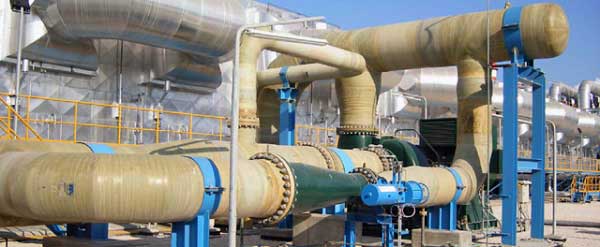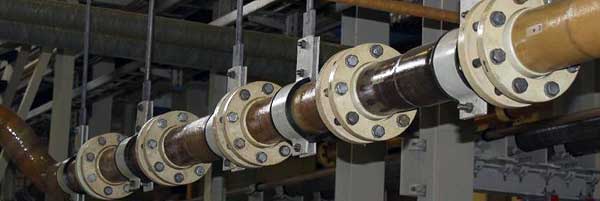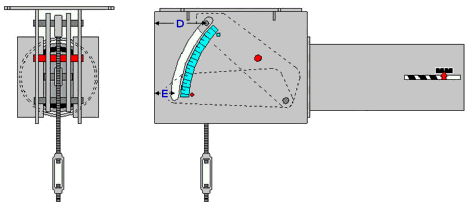Fiberglass GRP GRE FRP pipe supports
The design of pipe supports for fiberglass pipelines follows the same basic principles as other metal pipelines. Supports are designed to limit deflection and allowable stresses within design limits. Manufacturer's recommendations should be followed for supporting fiberglass pipelines.
Fiberglass reinforced pipe is an anisotropic composite material that results in different modulus values under tensile, bending and compression.

Image.. grpgulf.com
The modulus again varies depending on the type of resin, the amount of glass and the direction of the reinforcement used. Care should be taken to ensure that the correct modulus is used, which should come from the manufacturer.
Fiberglass pipes do not have the same outside diameter as steel pipes, and thermal expansion is two to five times greater than that of steel. As a result, support components such as pipe clamps must be adapted for fiberglass pipelines.
In addition, axial expansion due to internal pressure can be significant for fiberglass pipes. Keep in mind that the load due to compressive expansion is only applicable during directional changes.
For fiberglass piping systems, the support distance is smaller than for steel piping, but larger than for thermoplastic piping. Refer to the specific technical bulletin for each piping system for recommended support distances.
The type of support to use for a specific application depends on a number of factors, the most important of which are the intended function of the support and the configuration of the available structural steel. The basic types of supports are weight supports, guides and anchors.
In general, supports for fiberglass pipe systems will be wider and more robust than for metal pipes to prevent point loads and keep the fiberglass pipe round. All supports (except flange supports) are lined with rubber to prevent wear on the fiberglass.
General Supports
Supports not only provide system fixation, relief and clinching, but also protection. Before installation, supports checked for location, type and span as described in the project drawings and specifications. Supports can be differentiated into fixed, guided slide and free sliding supports.
Functional pipe support can be obtained using of system design analysis.
The following aspects should be considered:
- Pipes resting on sleepers are supplied with 180° saddles, which are glued to the pipe at the support location to protect the pipe from damage, and to protect the pipe from wear damage due to possible movement of the pipe.
- The length of the wear saddle should be 50 mm longer than the calculated tube displacement plus the support width.
- Allow pipe expansion within a clamp.
- For vertical pipe assemblies, the sockets of the O-ring connections must face downward to prevent water from entering the socket. Trapped water in the socket can cause damage to the joint if it freezes.
- For clamp dimensions, refer to detailed manufacturer's documentation.
- Pipes with mechanical O-ring joints require at least one support per pipe length. The distance from the support to the joint is a maximum of 20% of the pipe length.
Fixed support points
Fixed points should never be realized by tightening the bolts of the pipe clamps. This can lead to deformations and excessive wall stresses.
Consider the following requirements for fixed points:
- Attachment saddles should be on both sides, on the shoe side of the clamp.
- Laminated fastening saddles are applied to both sides of the clamp.
- When using non-tensioned joint systems, each pipe must be secured.
- Any change of direction in a non-tensioned pipeline must be anchored to prevent pipe joints from falling apart.
- Check that the positions of the pipe supports still conform to the installation requirements after testing. The supporting elements may have been dislocated by the test pressure.

Pipe Clamps
Several types of pipe supports are available. The following considerations should be taken into account:
- Avoid point loads by clamping flat strips instead of U-bolts.
- The width of the strip is related to the pipe diameter. For large diameter pipes, double clamps can be used.
- The inside of the clamp has a rubber or cork liner to compensate for the uneven outer surface of the pipe and wear caused by pipe movement and vibration.
- Longitudinal movement in the clamps is not advised. In general, movement between the clamping shoe and the support structure should realize sliding of the supports.
Valves
To avoid overloading of pipes by the weight of valves or other heavy equipment, it is recommended that pipe accessories be supported on the flange bolts.
The load on the pipeline due to valve operation should be carried by the support of the pipe assembly. In the case of a Fiberglass flange mounted against a steel flange, the support is preferably attached to the steel flange.
Bellows
Fiberglass products can absorb low amplitude vibrations due to the flexible properties of the composite material. To eliminate high-amplitude vibrations caused by e.g. pumps, and to compensate for bottom settlement or expansion of e.g. tanks connected to pipes, bellows can be applied.
Bellows facilitate the disassembly of pipe shells, valves, orifice flanges and gaskets. These devices also absorb pipe movement due to cyclic pressure and/or temperature in piping systems connected with relatively rigid adhesive joints.
In many cases, bellows are connected directly to the vibrating element by flanges. Note that the pipe section adjacent to the bellows must be supported separately to accommodate the loads.
Bolt torque values as specified by the bellows supplier may differ from the torque values specified by the Fiberglass manufacturer.
The details about fiberglass supports described in the above article are only a summary of the usual supports. For non-daily designs, a fiberglass supplier can definitely tell you more.
Related Post(s)

Pipe is held either from above by hangers or supports of various types on which it rests. Hangers are also referred to as supports...